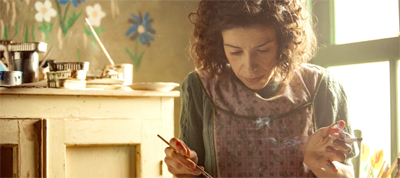This film was seen as part of the Audi Dublin International Film Festival 2017.
“Show me the way you see the world,” urges one buyer of Maud Lewis approximately half-way through Maudie, capturing the ageless appeal of just about any artistic vision. There is something exciting and unique about the opportunity to examine the world from a unique vantage point, to perceive time and space from the perspective of somebody else.
That is particularly true of Maud Lewis, the Canadian folk artist who captured the international imagination through the forties and into the fifties. Lewis had a very unique perspective on the world, capturing her surroundings and even people in crude two-dimensional terms with a surprising amount of depth. The little incongruous details of these seemingly simplistic paintings turned Lewis into a cultural icon, whose influence and legacy perseveres to this day.

Wedded to convenience.
The biggest problem with Maudie is that the film completely lacks any sense of original or distinctive vision, any real effort to see the world as it must have appeared to Maud Lewis. As much as the film and the surrounding characters might laud Maud for her distinct approach to painting, Maudie is a much more conventional tale. Maudie hits just about every biography cliché in the book, without offering any keen insight or shrewd observation. It lacks those small well-observed nuances that really brought Lewis’ work to life.
A superb central performance from Sally Hawkins cannot elevate a film that is so eager to engage in twee unreconstructed nostalgia.

Painting a pretty picture.
Maudie often feels like a postcard brought to life. It ironically works best in its quieter moments, with director Aisling Walsh capturing some wonderful establishing shots that feel like pure (North) America. Vintage cars drive down small country roads as the sun sets, fields of barley swaying gently in the evening wind. Snow covers the landscape, including the small bridge over a tiny gully and the quaint little shack that the title character calls home. Maudie works best in those quiet moments.
However, it loses its footing whenever it tries to engage a narrative. Maud Lewis is an absolutely fascinating character, but Maudie seems to have very little insightful to say about here. Maudie hits each and every plot beat expected of the artistic biopic, in precisely the expected manner. Domestic abuse. Crisis of confidence. Artistic success, and the question of who profits from same. Intrusion of celebrity. When the film reaches the title character’s eventual passing, it shamelessly milks her deterioration in a manner that feels almost cynical.

Brushing over the details…
To be fair, Maudie suffers in large part because this ground has been well-trodden. After all, artistic biographies like Walk the Line and Ray cemented the template for a modern generation of audiences, to the point that the genre could be mercilessly skewered by Walk Hard: The Dewey Cox Story. Maud Lewis might be a painter rather than a musician, but the script still crafts her narrative to the contours of that familiar formula. The audience can time the beats to the second.
This feels particularly disappointing given the emphasis that the film places on Maud’s unique vision and sensibility. Maud Lewis saw the world in a very distinctive way, and it feels like a disservice to reduce her life to such a stock pattern. Maudie often luxuriates in the stock tropes of mid-twentieth century North Americana. Everett Lewis might hail from Nova Scotia rather than New Orleans, but he fits the brooding brutish template of vintage literary characters like Stanley Kowalski. He feels more like an archetype than a character.

Watching like a Hawke…
This leads to a number of awkward dissonances within Maudie. The film portrays the relationship between Maud and Everett Lewis in a very frank and straightforward manner, including Everett’s stoicism and violence. However, the film also awkwardly romancises Everett, casting a certain nobility in his abusive behaviour to Maud. There is something faintly patronising in this. “They live on bare essentials,” one newscaster observes of the couple. “But they seem to thrive.” Maud and Everett do not feel like real people, but living nostalgia.
This is a shame, because Sally Hawkins does great work in the title role. For all that Maudie is unable to look at the world from Maudie’s perspective, Hawkins still seems to crawl inside her head. Hawkins plays Maud as a character with a barely-hidden mischievous streak beneath her plain-spoken exterior, suggesting an interesting contrast to the straightforward romanticism of the surrounding film. However, these moments always feel like they exist at a remove, the film always retreating to her innocence and her straightforwardness.

… er, no. Wait.
Watching like a Hawkins.
Maudie is a beautiful film to look at, especially in those moments when it allows its attention to drift away from a very paint-by-numbers biography. However, while the film might skilfully capture the superficial simplicity of Maud Lewis’ work, it never quite manages to find those little details that allowed her paintings to stand the test of time. It’s far too Maud-lin.
I don’t normally rate films, but the Audi Dublin International Film Festival asks the audience to rank a film from 1 (worst) to 4 (best). In the interest of full and frank disclosure, I ranked this film: 2
Filed under: Non-Review Reviews | Tagged: adiff 2017, ethan hawke, film, maudie, non-review review, review, Sally Hawkins |




















Leave a comment